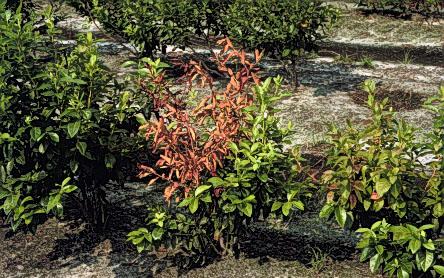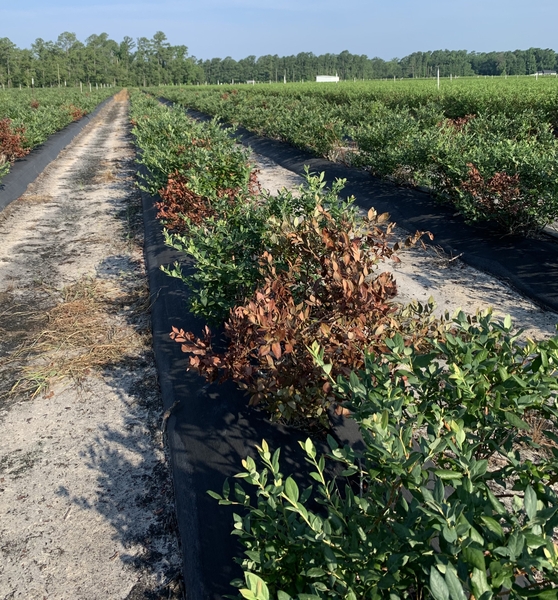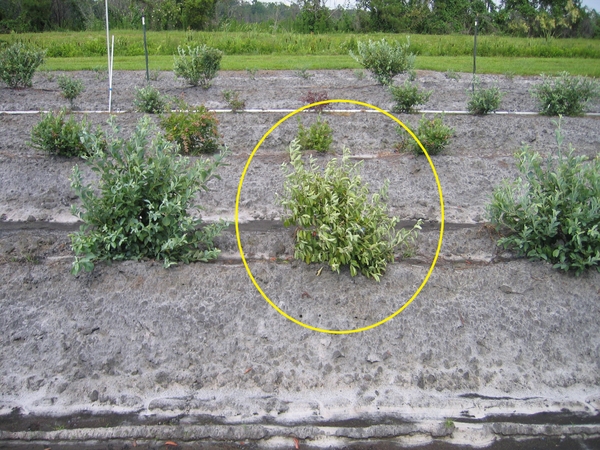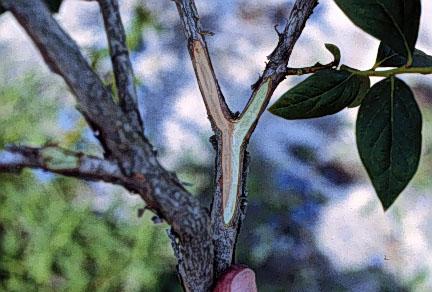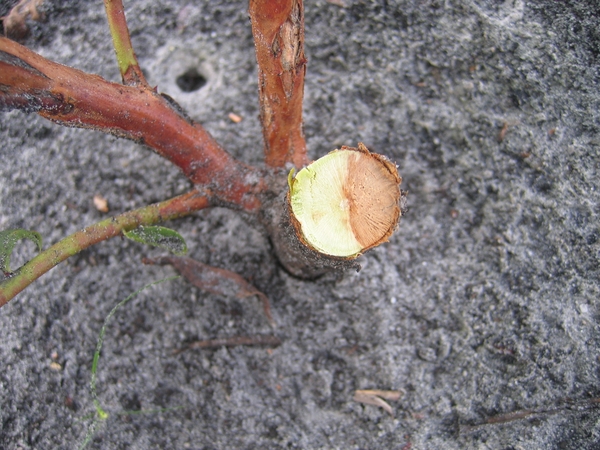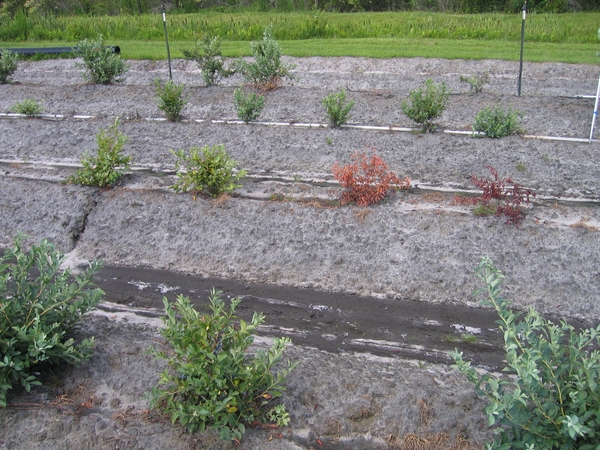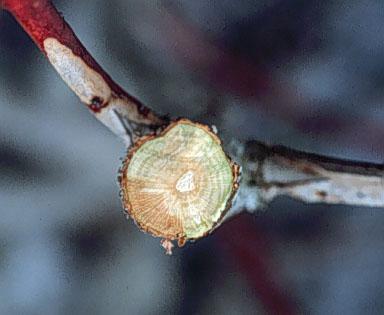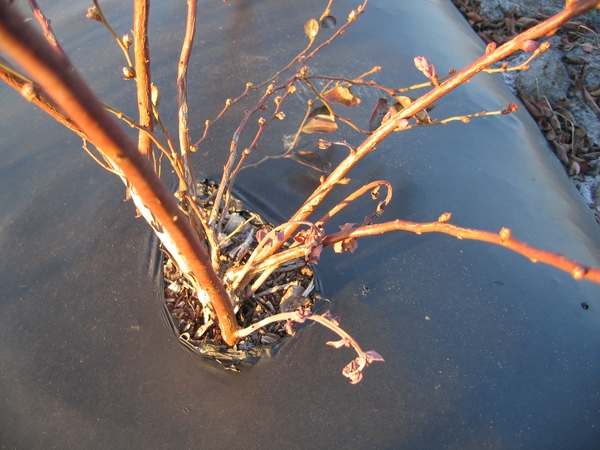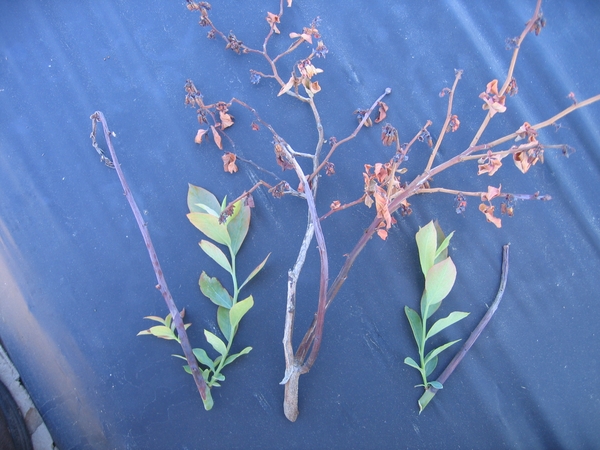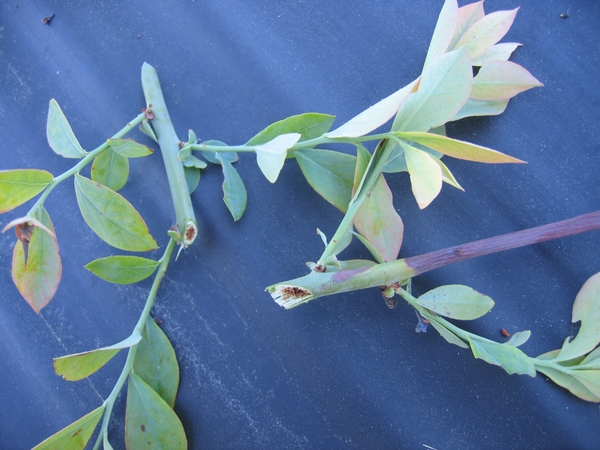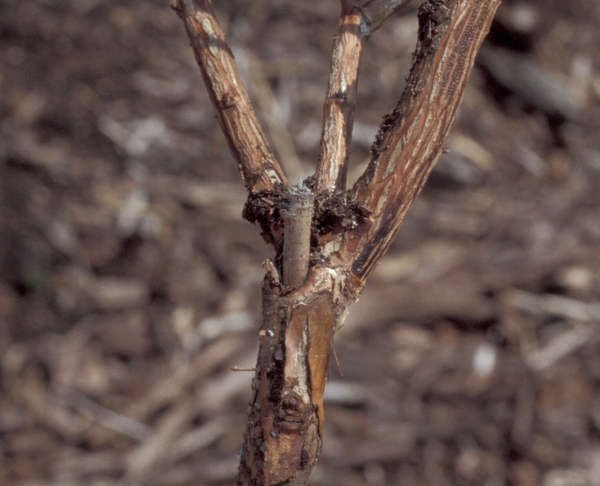General Information
Blueberry stem blight, caused by the fungus Botryosphaeria dothidea and related species, is the primary disease limiting establishment of blueberry plantings in southeastern North Carolina. Both highbush and rabbiteye cultivars are susceptible to this disease. The fungus enters the plant through wounds and causes rapid death of individual canes and entire bushes. The disease is especially severe on 1- and 2-year-old plantings of susceptible cultivars. Young bushes grown in high-organic muck soils with abundant natural fertility are often overly-vigorous, and late season succulent shoots can be cold-damaged in the Fall -- infection of these cold-damaged stems the following Spring leads to plant death the following Summer.
Symptoms
The stem blight fungus causes a rapid wilt with browning or reddening of leaves on individual branches, often followed by death of the entire plant as the fungus spreads downward through vascular tissue to the base of the plant. Most infections can be traced to a wound as the initial point of infection. In the field, the most obvious symptom is called 'flagging'; stems recently killed by the fungus do not drop their leaves, resulting in a brown-leafed 'flag' which stands out against the green healthy portions of the bush. Further diagnosis can be accomplished by removing a wilting stem that has both dead and healthy portions and splitting it longitudinally. A stem blight-infected stem will have a uniform, light brown discoloration in the wood extending down the infected side of the stem.
In a normal year, stem blight infections become evident in June, soon after harvest in southeastern North Carolina. New infections can be observed throughout the summer months. Infections are usually associated with a wound, often late-season cold injury on succulent shoots that occurred during the previous growing season. Infected stems quickly wilt and die. The infection can also develop in wounds at the base (crown) of the bush in susceptible cultivars, resulting in rapid plant death without the typical flagging symptom associated with infections on individual stems. Winter temperatures below zero (0 °F) have also been observed to cause cracking in the forks of blueberry stems, resulting in wound-related epidemics in March and April. Damage from contact herbicides (paraquat, glufosinate) can serve as an entry point for the stem blight pathogen.
Disease Cycle
This fungus overwinters in dead and infected stems. The disease also occurs on many other wild and cultivated plant species (including alder, holly, wax myrtle, blackberry and willow). Thsi wide host range contributes to the survival and spread of the disease.
Spores are carried by wind and rain from infected stems to wounds on healthy plants. These spores germinate and invade the vascular tissue of the host, causing a pecan-brown discoloration which extends up and down the stem from the infection point, eventually killing the stem. Stems killed by the stem blight fungus eventually drop their leaves after a few weeks and turn dark brown to black in color; these dead infected stems are noticeably darker than stems dying due to other causes. Fungal fruiting bodies are produced all along the stem just under the surface, and spores are released which spread to wounds on adjacent bushes. These spores are released year-round with the exception of a few weeks in winter; however, the greatest numbers of infections occur in early summer.
Control
Control of this disease depends on the use of clean planting stock, pruning, and fertility managment. Fungicides do not provide adequate protection.
The use of clean planting stock has greatly reduced the incidence of stem blight in NC. The stem blight fungus can be introduced into a new planting on infected planting stock, and this is most likely to occur with bushes propagated from hardwood cuttings. Plants propagated using tissue culture or from softwood cuttings are more likely to be disease-free.
Pruning to remove infected stems is the best method of reducing disease in established fields. Pruning serves two control functions: 1) It removes infections from bushes, preventing eventual death of the individual stem or plant, and 2) it reduces the number of spores released in the field by removing dead, spore-bearing stems. Pruning can be done anytime infected stems are observed, but care should be taken to cut well below the infected area. After a stem is cut off, examine the cut end of the remaining stem. If any brown areas are visible in this cross-section, the cut must be made again further down the stem until all infected tissue is removed. Infected prunings should be removed well away from the field and burned or shredded.
Removal of cold-damaged basal shoots is critical in fields where succulent shoots on young vigorous bushes have been damaged by the first hard freeze in the Fall. If left in place, these cold-damaged shoots provide an entry point for the stem blight pathogen. Cold-damaged shoots can be identified by the crook at the tip where the shoot wilted after freezing. The pith (center) of cold-damaged shoots is brown. These shoots should be removed entirely or cut back to the point where no brown pith remains.
Fertilizer management is neccessary to prevent formation of succulent shoots late in the growing season. Infection of cold-injured shoots around the base of the bush is a primary means by which this fungus enters blueberry plants. Fertilizer should not be used after mid-summer, especially on young bushes. This will allow bushes to enter a natural dormancy and will reduce the chance of fall cold injury. On soils with a high organic content (>5%), new plantings can be established without the use of fertilizer.
Site selection appears to play a part in the severity of stem blight. The worst cases of stem blight in commercial fields occur on soils which are extremely sandy, resulting in poor growth, or on the black, heavy muck soils that promote excessive growth.
Avoid wounding bushes unnecessarily. Since stem blight is most damaging to young plantings, heavy pruning to promote rapid growth should be avoided in 1- to 2-year-old plantings; pruning in young plantings should be limited to removal of stem blight-infected canes. Another wounding phenomenon which occurs in new fields is caused by termites. In recently cleared fields where old stumps, trunks and branches have been left buried in the field, termites have been observed to wound and even kill new bushes. This can be avoided by thorough field preparation to remove old stumps and roots prior to planting.
Other Resources
- FDIN010 Twig Blight of Blueberry
- Fruit Disease Notes
- IPM Fruit Information for North Carolina
- Horticulture Information Leaflets (HIL)
- North Carolina Entomology Insect Notes
- North Carolina Agricultural Chemicals Manual
For assistance with a specific problem, contact your local N.C. Cooperative Extension center.
Publication date: Dec. 17, 2013
Reviewed/Revised: Jan. 3, 2024
Recommendations for the use of agricultural chemicals are included in this publication as a convenience to the reader. The use of brand names and any mention or listing of commercial products or services in this publication does not imply endorsement by NC State University or N.C. A&T State University nor discrimination against similar products or services not mentioned. Individuals who use agricultural chemicals are responsible for ensuring that the intended use complies with current regulations and conforms to the product label. Be sure to obtain current information about usage regulations and examine a current product label before applying any chemical. For assistance, contact your local N.C. Cooperative Extension county center.
N.C. Cooperative Extension prohibits discrimination and harassment regardless of age, color, disability, family and marital status, gender identity, national origin, political beliefs, race, religion, sex (including pregnancy), sexual orientation and veteran status.

